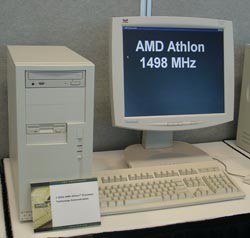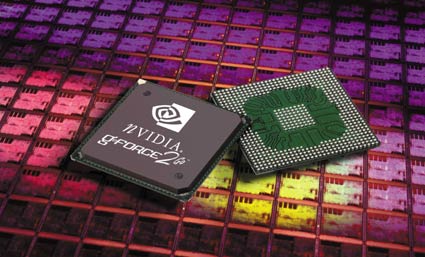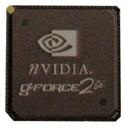Van Smith van Tom's Hardware Guide heeft vandaag voor ons een verhaaltje geschreven over de eerste dag van Comdex. De eerste dag staat bij THG in het teken van AMD en derhalve zien we in het artikel informatie over de dode Mustang, de springlevende Palomino, de Hammer familie en over de move naar een 0.13 micron productieproces. Over dit laatste een klein hapje tekst:
The semiconductor sauropod, Intel, has been making a lot of noise lately about its upcoming move to a 0.13 micron copper fabrication process. Sliding down to this finer technology will enable the Santa Clara company to literally shrink its chips, allowing them to run faster while consuming less power.
Again being evasive on specifics, AMD representatives did point to their roadmap as a means to glean when the company will be moving down to their own 0.13 process. Although AMD's Silicon on Insulator (SOI) copper process is arguably more sophisticated than Intel's (which snubs SOI), if AMD's roadmap is a true indicator of when their 0.13 process goes online, then AMD might have problems. The earliest chips using this process, the Thoroughbred and the 64-bit ClawHammer, are not slated to appear until early 2002. This gives the appearance that AMD will be about six months behind Intel in migrating to 0.13 microns.
We pressed our friendly AMD representatives for their opinions as to whether this apparent lag in process technology will be an issue for their company. They replied in unison that, while Intel might "paper launch" 0.13 micron products in late Q2 of 2001, the Santa Clara rival would not likely be reaching quantity production until roughly the same time as AMD, six or seven months later in early 2002.
![]() Een 760MP demo-systeem:
Een 760MP demo-systeem:
 |

 So how fast is it?
So how fast is it?






 192)
192) 1)
1) )
) Apple maakt in haar systemen gebruik van Motorola-processors. Deze CPU's verschillen in aansturing van de processors die gebruikt worden in pc's (ondermeer Intel en AMD).
Apple maakt in haar systemen gebruik van Motorola-processors. Deze CPU's verschillen in aansturing van de processors die gebruikt worden in pc's (ondermeer Intel en AMD).


 We ve found out some details concerning mainboards chipsets that NVIDIA is about to manufacture. It s entirely possible that its chipsets called Crush will be already announced in November. In the first version of Crush that will be made for both Intel Pentium III and AMD Athlon processors there will be used NV11 (GeForce2 MX) as an integrated graphics core. But later NVIDIA plans to improve the performance of this graphics core. Crush will support PC1600/PC2100 DDR SDRAM.
We ve found out some details concerning mainboards chipsets that NVIDIA is about to manufacture. It s entirely possible that its chipsets called Crush will be already announced in November. In the first version of Crush that will be made for both Intel Pentium III and AMD Athlon processors there will be used NV11 (GeForce2 MX) as an integrated graphics core. But later NVIDIA plans to improve the performance of this graphics core. Crush will support PC1600/PC2100 DDR SDRAM.

 GeForce2 Go allows business users, artists, and gaming enthusiasts to create, present and entertain anywhere, anytime. As the world's first mobile graphics processor supporting transform and lighting in hardware, GeForce2 Go delivers breakthrough 3D rendering power, up to ten times faster than that of standard notebooks, processing more than 17 million triangles/second and 286 million pixels/second with a memory bandwidth of 2.6 GB/second. Available in configurations of up to 32MB of DDR SDRAM memory, GeForce2 Go is the first to offer DDR memory on the notebook for responsive graphics.
GeForce2 Go allows business users, artists, and gaming enthusiasts to create, present and entertain anywhere, anytime. As the world's first mobile graphics processor supporting transform and lighting in hardware, GeForce2 Go delivers breakthrough 3D rendering power, up to ten times faster than that of standard notebooks, processing more than 17 million triangles/second and 286 million pixels/second with a memory bandwidth of 2.6 GB/second. Available in configurations of up to 32MB of DDR SDRAM memory, GeForce2 Go is the first to offer DDR memory on the notebook for responsive graphics.
 Recognising the increasing usage of audio for CD Recording, a complete and non-destructive audio editor is now included in Nero 5.5. Likewise for the creation of compatible MPEG data for Video CD recording, a full MPEG 1 video encoder is incorporated, along with a VCD/SVCD menu creator. An advanced cover editor now gives a level of editable control, until now absent from integrated software packages.
Recognising the increasing usage of audio for CD Recording, a complete and non-destructive audio editor is now included in Nero 5.5. Likewise for the creation of compatible MPEG data for Video CD recording, a full MPEG 1 video encoder is incorporated, along with a VCD/SVCD menu creator. An advanced cover editor now gives a level of editable control, until now absent from integrated software packages.